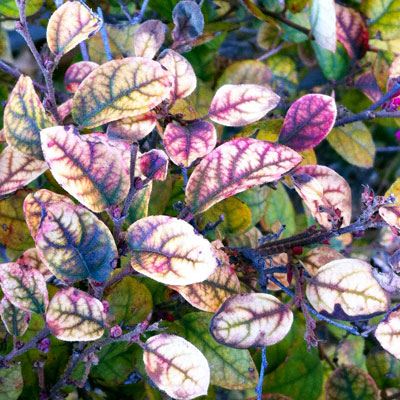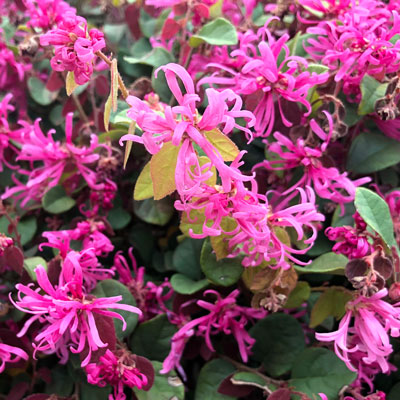Question of the Week – Number Two: June 4, 2020
“My loropetalums are turning splotchy and yellow. What can I do to make them look better?”

Loropetalums came into our market almost 30 years ago, and many of us were mighty excited to see them.
For some of us, that excitement continues on. For the most part, those are folks who live east of I-45. That means that they garden where soils are acidic. That matters with this plant.
The rest of us have less impressive stories to tell because our plants gradually faded from the rich, burgundy red to streaked yellowish-green. Our plants became weaker and weaker, and many of us either lost them entirely or we got so tired of the bad looks that we removed them and turned to some other species.

This is iron deficiency. We were told that loropetalums needed acidic soils when we met them. We were told that we’d have to plant them in conditions similar to what we’d give azaleas and gardenias. East Texans just took note and got out their shovels.
Central and West Texans, on the other hand, if they were smart, replaced their native soil with 12 to 18 inches of highly organic planting mix. Taller varieties needed deeper planting soil, while the small, weeping types could get by with less.
Unfortunately, many people didn’t get the soil-prep memo, and they just planted their fringeflowers directly into alkaline soils.
In the long run, that didn’t matter much, because those of us who planted in organic matter watched it decay and lose its effectiveness after 4 or 5 years, and our plants were right back to the starting point – growing in the alkaline native soil.

Here’s where the rub comes in…
When you grow a plant that needs a great deal of iron in an alkaline soil, the iron in that soil is insoluble. It won’t dissolve in water, so the plants’ roots can’t take it up into the plants. Leaves are the points farthest from the roots, so that’s where iron deficiency shows up first and leaves last.
You could try to add iron and a sulfur soil acidifier to help the plants correct their iron deficiency problems. That would seem logical. But that’s very difficult to do on a sustained basis. You have to treat every 4-6 weeks each summer if you have a really serious problem. Even that may not turn things around. (Remember that much of Texas irrigation water from municipal sources is even more alkaline than the native soils in those areas, further compounding the problems.)
If you have a loropetalum that’s showing terrible iron deficiency, go ahead and try bolstering its appearance by adding iron and sulfur. (The sulfur theoretically will help keep the iron soluble longer.)
But if the plant doesn’t respond very well – if it looks just about as bad a month or two later, perhaps you’ll decide to do what I’ve done: As long as I live and garden in alkaline soils, loropetalums are on my “Never again!” list. I’ll find some other way to fill those spaces.
At the same time, for my friends in East Texas, and for anyone who does better with these plants than I do in the rest of the state, I salute you in awe. Go for it!

